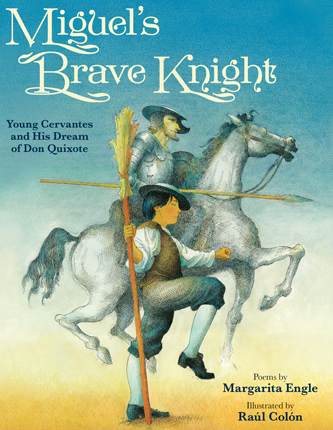| Miguel's brave knight : young Cervantes and his dream of Don Quixote Author: Engle, Margarita | ||
| Price: $6.50 | ||
Summary:
This fictionalized first-person biography in verse of Miguel de Cervantes follows the early years of the child who grows up to pen Don Quixote, the first modern novel.
| Illustrator: | Colon, Raul |
| Accelerated Reader Information: Interest Level: MG Reading Level: 4.30 Points: .5 Quiz: 189614 | Reading Counts Information: Interest Level: 3-5 Reading Level: 6.40 Points: 3.0 Quiz: 72435 | |
Reviews:
Kirkus Reviews (+) (08/15/17)
School Library Journal (+) (09/01/17)
Booklist (+) (08/01/17)
The Bulletin of the Center for Children's Books (00/09/17)
Full Text Reviews:
Booklist - 08/01/2017 *Starred Review* Fifteen brief poems introduce readers to the early life of Don Quixote author Miguel de Cervantes. Through themed verses, Engle emphasizes the stories told by Cervantes’ mother that sparked his imagination; the hunger his family experienced after Miguel’s father was sent to debtor’s prison; Miguel’s pleasure whenever he was able to attend school; and his daydreams about a brave, helpful knight that helped him to anticipate a better future. Engle’s poems are lyrical yet direct, each describing a single significant event. “Disaster,” for example, addresses the plague: “No school. / No teacher. / No books. / Just sorrowful / prayers. / But I still carry invisible stories / in my head, my daydreamed tales / help calm / my worries.” Colón’s pen, ink, and watercolor illustrations (inspired by the prints of Gustav Doré) accompany every poem, bringing Engle’s words into sharp focus. Some depict actual places and events, while others represent scenes from Cervantes’ novel. The use of a limited palette (earth tones with blue and yellow accents) and distinctive costuming will help readers to better appreciate the sixteenth-century Spanish setting. Author and illustrator notes (as well as historical and biographical information) further clarify Cervantes for the intended audience. An intriguing, lightly fictionalized introduction to an iconic author, this will encourage readers to learn more about the first modern novel. - Copyright 2017 Booklist.
School Library Journal - 09/01/2017 Gr 3–6—In a collection of poems, Engle explores the great Spanish writer's early beginnings. Miguel Cervantes's vivid imagination and love of storytelling are presented against the backdrop of his difficult childhood as the son of a vagabond barber-surgeon who often gambled away his family's money. Despite the constant relocation across Spain because of his father's debts, the boy reveled in dreaming about a bumbling knight slaying imaginary monsters. His adoration of books and learning kept him going, and Engle's mastery of the written word is evident in these lyrical verses. Colón's pen-and-ink and watercolor illustrations are paired perfectly with the text and the subject. The sketchy browns, beiges, and teals give a dreamy quality to the narrative, and Cervantes's imaginings often float above renderings of his real-world setting. The poems' headings are presented in bold type and in faint watercolor, adding visual drama to the pages. Don Quixote appears beside the last poem, reminding readers of Cervantes's legacy. The book concludes with author's and illustrator's notes, historical and biographical notes, and more information about how Don Quixote, published in 1605 and credited as the first modern novel, has inspired artists for centuries. VERDICT This expressive picture book biography presents a solid argument for why Cervantes should be revered as an important figure in the Western canon. A gorgeous and well-crafted work for all nonfiction collections.—Shelley M. Diaz, School Library Journal - Copyright 2017 Publishers Weekly, Library Journal and/or School Library Journal used with permission.



